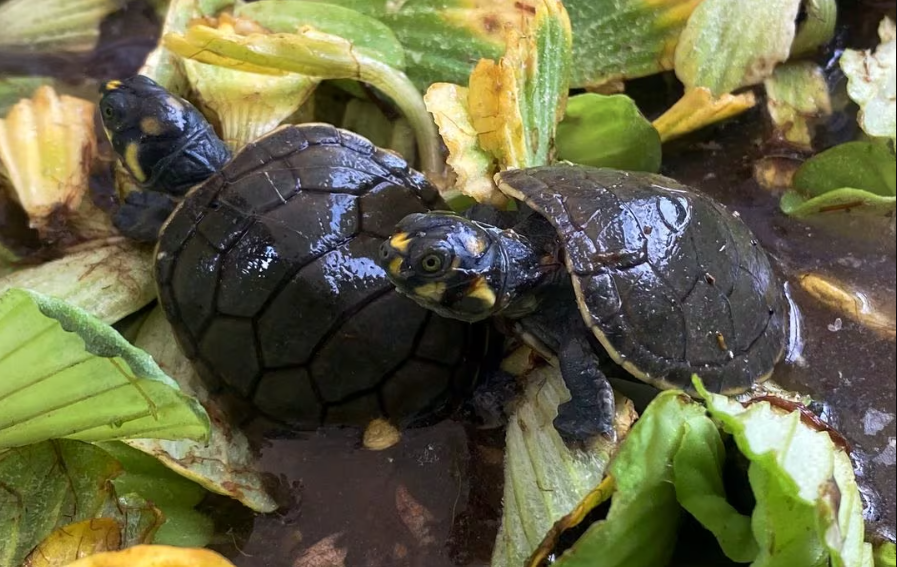
©REUTERS/Alfredo Galarza
Vocabulary:
I will read the words, meanings, and sample sentences. Then, repeat after me.
- drought /drout/
- brink /bringk /
- accelerated /uhk-SEH-lr-ay-tuhd/
- paramount /PAR-uh-mount/
- succumb /suh-KUHM/
[noun] – a long period when there is little or no rain
The region has been experiencing a severe drought, causing widespread crop failures.
[noun] – the edge of a steep place
Standing on the brink, the adventurer marveled at the vast expanse below.
[adjective] – faster than usual
The accelerated development of the software allowed the team to launch the product ahead of schedule.
[adjective] – more important than anything else, supreme
Ensuring the safety of passengers is paramount for the airline industry.
[verb] – to fail to resist pressure, temptation, or some other negative force; to give way or yield to something.
Despite his efforts to stay healthy, he eventually succumbed to the illness.
Article reading:
Please read the whole article. Then, I will check your pronunciation and intonation.
In the verdant Amazon region of Peru, an extraordinary environmental endeavor is being conducted to augment the population of the yellow-spotted Amazon river turtles, colloquially known as taricayas. Recently, a considerable cohort of these turtles, precisely 3,200, were liberated into the river by zealous biologists. This initiative is a constituent of an expansive conservation program designed to rejuvenate the taricaya species, which is beleaguered by the perils of hunting. The expeditious release of the turtles, distinguished by their brown or olive-colored carapaces embellished with yellow spots and black scales, was precipitated by an acute heat wave and drought. These exacerbated conditions truncated the turtles’ incubation period from the customary 60–72 days to approximately 45 days. The diminutive hatchlings, mere centimeters in stature, were meticulously conveyed to the river’s brink in containers and subsequently emancipated into the aquatic milieu with the aid of local progeny.
The accelerated hatching of turtles in Peru’s Amazon can be attributed to elevated temperatures and a pronounced drought, ramifications of the El Niño climatic phenomenon. El Niño engenders an upsurge in Pacific Ocean temperatures and diverse meteorological consequences, such as copious coastal precipitation, Amazonian heat waves, and droughts. The conservation of the Amazon rainforest is paramount to the amelioration of catastrophic climate change, given its prodigious capacity for sequestering greenhouse gases. Notwithstanding this imperative, over the preceding two decades, extensive tracts of the Peruvian Amazon have succumbed to deforestation. Biologist Zabryna Pipa Perea, representing the Amarumayu Movement—a consortium devoted to the preservation of Amazonian fauna—underscored the significance of their endeavor in liberating 3,200 turtles, cumulatively enhancing the tally to 23,000, thereby making a substantial contribution to the species’ resurgence.
The accelerated hatching of turtles in Peru’s Amazon can be attributed to elevated temperatures and a pronounced drought, ramifications of the El Niño climatic phenomenon. El Niño engenders an upsurge in Pacific Ocean temperatures and diverse meteorological consequences, such as copious coastal precipitation, Amazonian heat waves, and droughts. The conservation of the Amazon rainforest is paramount to the amelioration of catastrophic climate change, given its prodigious capacity for sequestering greenhouse gases. Notwithstanding this imperative, over the preceding two decades, extensive tracts of the Peruvian Amazon have succumbed to deforestation. Biologist Zabryna Pipa Perea, representing the Amarumayu Movement—a consortium devoted to the preservation of Amazonian fauna—underscored the significance of their endeavor in liberating 3,200 turtles, cumulatively enhancing the tally to 23,000, thereby making a substantial contribution to the species’ resurgence.
Discussion Questions:
I will read each question. Then, please answer them.
- Have you ever participated in or witnessed a wildlife conservation activity, such as the release of animals into their natural habitat? If yes, how did the experience impact your views on conservation and wildlife? If not, would you be interested in taking part in such an activity? Why or why not?
- Do environmental issues like climate change and deforestation influence your daily choices, such as the products you buy or the way you travel? If yes, in what ways have you adapted your lifestyle to be more environmentally friendly? If not, what are the factors that make it challenging for you to incorporate these considerations into your daily life?
- Do you believe that individual actions can significantly contribute to solving major environmental issues like climate change and deforestation?
- In what ways do you think global environmental policies and individual actions can be effectively aligned to address the challenges posed by climate change and deforestation, especially in critical areas like the Amazon?
- Considering the complex relationship between economic development and environmental conservation, how can countries balance the need for economic growth with the imperative to preserve natural habitats and biodiversity?
Summarization
Please summarize the whole article using your own words and expressions. You will have one minute to prepare before you answer.
Describe:
Please explain the definition of each word listed below based on your understanding. You can provide example sentences if needed.
- attribute
- aid
- convey
- customary
- initiative